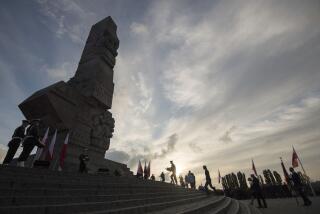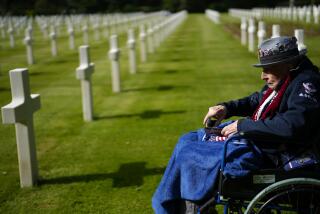Return to a Dark Place
OSWIECIM, Poland — Marian Turski was 18 when he arrived at the Auschwitz-Birkenau railway platform in the summer of 1944.
A member of an illegal political group in the Jewish ghetto of the central Polish city of Lodz, he had heard of the Nazi death camp on clandestine BBC radio broadcasts. But nothing prepared him for what lay ahead.
It was before dawn. The chimneys of the crematoriums spewed flames and smoke. At the platform, Nazis decided in seconds who was going to live -- for a while -- and who would be sent directly to the gas chambers.
Turski, considered fit for labor, was given a chance to live.
“It was a happy day,” said Turski, now 78, oblivious to how incongruous his words sounded.
His father and brother were not as lucky. They and more than a million others died at Auschwitz between 1940 and 1945.
Today, leaders from dozens of nations, including Vice President Dick Cheney, along with Auschwitz survivors and those who freed them will gather in a solemn ceremony here to mark the 60th anniversary of the camp’s liberation by the Soviet army. They will ponder man’s capacity for evil, and renew pledges that such acts will never happen again.
With survivors such as Turski nearing the end of their lives, this year’s ceremony marks one of the last occasions to bring together so many people to bear witness, said Auschwitz museum historian Franciszek Piper, whose office is one of the camp barracks.
“Without testimony there would be no knowledge, because documents don’t say much,” said Piper, who has worked 40 years at the museum documenting witnesses’ accounts.
August Kowalczyk, 83, a retired Polish actor, was sent to Auschwitz in 1940 at age 18. Stealing one potato, he recalled, could lead to execution. He escaped after a year and a half.
He returns to the camp each November with an international peace group to pray, and he has visited more than 5,000 Polish schools to tell students about the Nazi atrocities.
“I think that it is my obligation as a witness to pass the knowledge I kept in my memory,” said Kowalczyk, who will take part in today’s ceremonies at Auschwitz. “There is no other place in the world where so many hungry souls want us to remember them.”
Three former prisoners representing the largest groups of victims -- Jews, Poles and Gypsies -- will open the commemoration ceremonies. Historians such as Piper hope the 60th anniversary will make Europeans more aware that although Auschwitz was mainly a Jewish experience, it clearly represented a crisis for European civilization.
“Unfortunately, even today we are encountering Auschwitzes on a smaller scale, as nationalist hatreds lead to mass murder” in places such as Sudan and Rwanda, Piper said.
He and other historians believe that as the survivors of World War II’s horrors disappear, the need to educate a new generation grows. Britain’s Prince Harry recently shocked the world by wearing a Nazi costume to a party, an act that led many to recommend he visit Auschwitz.
Rene Felske, a student from Bernau, Germany, is the same age as Turski and Kowalczyk were when they were sent to Auschwitz. On a school trip to the camp, Felske said it was hard to believe that Germans were responsible for such atrocity.
“Most young people don’t really know about it, or maybe they know but can’t imagine,” he said.
The Nazis opened the camp in the summer of 1940 here in Oswiecim, after occupying Poland. It was initially intended to confine Polish opponents of Hitler. Auschwitz was the German name given to Oswiecim.
In 1942, the camp was expanded and Birkenau, two miles away, was added. The focus shifted to Hitler’s “Final Solution,” the drive to exterminate the Jewish race. Though most of those slain at Auschwitz-Birkenau were Jews, about 75,000 non-Jewish Poles and 20,000 Gypsies also died there.
Today, visitors come from around the globe. The camp is a popular stopover for tourists traveling between Krakow and the mountain resort of Zakopane. For others, it is more than a side trip.
Tzvika Gross, a 31-year-old accountant from Israel, visited Auschwitz recently with his father and younger brother. More than 100 of their relatives, Hungarian Jews, lost their lives in the gas chambers of the camp.
Looking at a pile of inmates’ suitcases at the museum, they discovered one with the name Ella Neuman, possibly a relative on Gross’ grandmother’s side.
“This is really difficult for me,” Gross said. “I remember grandparents telling me horrible stories. The amount of blood shed here is like a wound that never heals.”
For Turski -- a historian and member of the International Auschwitz Council who lectures on the Holocaust worldwide -- the trauma was so great that his memory of the camp was blank for years after the war.
“I was touched by a kind of amnesia, as if some fog clouded my memory,” he said, sitting in his Warsaw apartment. “My mind created some great self- defense mechanism, making it possible for me to go on living.”
When a friend once thanked Turski for saving his life during a death march -- when the Nazis evacuated thousands of prisoners from the camp as Soviet troops advanced -- Turski realized he had no recollection of it.
For 20 years he could not bring himself to visit the camp. But after his first trip back, in the 1960s, he felt compelled to explore it, understand it, spread his message about it. He avidly read testimony, gave lectures, wrote books and newspaper articles.
He says he was blessed with a gift in being able to do it without the trauma that haunts many of his survivor friends. But 60 years after the camp’s liberation, Turski puts his historian’s passion into others’ experiences, not his own.
“I can research it, lecture on it, but even today I’m not able to come to terms with my own memories,” he said.
Turski calls Auschwitz an expression of Europe’s pain and collapse of values. Its symbolism today is even more profound, he said, because in the 10 years since the 50th anniversary of the liberation, the world has witnessed atrocities from the Balkans to Africa.
“We thought it all belonged to the past,” he said.
Recent visitor June Clarke, a 55-year-old British recruitment consultant from Yorkshire, emerged visibly shaken from the Auschwitz museum.
Looking at the infamous “Arbeit macht frei” (Work makes you free) sign over the gate to the main Auschwitz camp, Clarke shook her head.
“They don’t give you a warning on how horrible it was,” she said. “We have to learn from it, never forget, and make sure it never happens again.”
More to Read
Sign up for Essential California
The most important California stories and recommendations in your inbox every morning.
You may occasionally receive promotional content from the Los Angeles Times.










